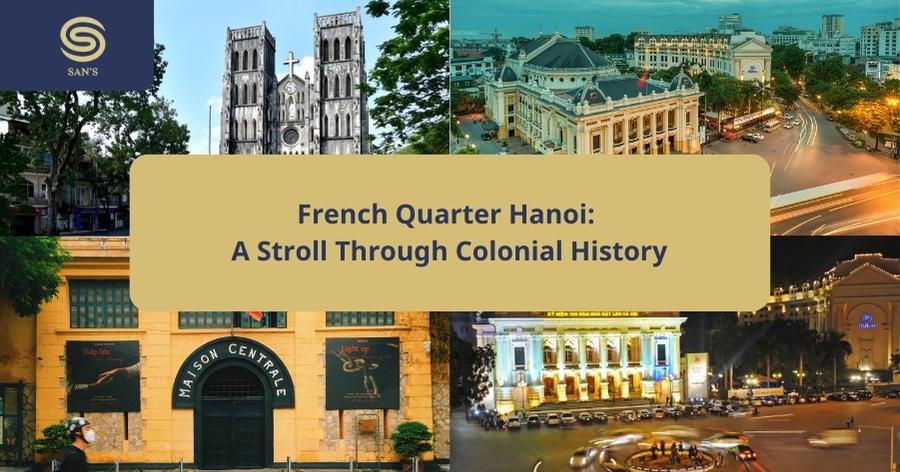Among the many districts in Hanoi, the French Quarter Hanoi stands out as a reminder of its colonial past. Known for its wide boulevards, elegant French architecture and rich cultural history, the French Quarter is a great stop. Join Sanhotelseries as he strolls through the historic streets, discovering the famous landmarks right away.
Overview of French Quarter Hanoi
The French Quarter Hanoi, located southeast of Hoan Kiem Lake, is a complete contrast to the narrow, bustling streets of the Old Quarter northwest of Hoan Kiem Lake. Its layout, influenced by European city planning, is characterized by wide, tree-lined avenues and imposing colonial-era buildings. The district was established during the French colonization of Vietnam, starting in the late 19th century, and became the administrative hub for the French Indochina government.
Today, the French Quarter remains a vibrant part of Hanoi, with its mix of historical buildings, luxury hotels, embassies, and high-end restaurants. Walking through this area, visitors can admire grand colonial villas, government buildings, and cultural landmarks that reflect the architectural style of the French influence. The blend of French and Vietnamese culture can be seen not only in the architecture but also in the lifestyle and culinary offerings of the district.

Difference Between Hanoi French Quarter and Hanoi Old Quarter
While the French Quarter Hanoi and the Old Quarter are geographically close, they are worlds apart in terms of ambiance and architecture. Here’s a look at some of the key differences between these two iconic areas of Hanoi:
Architecture
The Old Quarter is famous for its narrow, winding streets and traditional Vietnamese tube houses that date back hundreds of years. These streets are lined with small shops, markets, and street vendors selling everything from souvenirs to street food. In contrast, the French Quarter Hanoi features wide boulevards, neoclassical buildings, and grand villas with French-style facades. Many of the buildings in the French Quarter were inspired by Parisian architecture, giving the area a distinctly European feel.
Atmosphere
The Old Quarter is lively, noisy, and nostalgic, with motorbikes zipping through the narrow streets and vendors calling out to passersby. It’s an overwhelming experience for the senses, but in the most enjoyable way. On the other hand, the French Quarter Hanoi offers a more serene and elegant experience.
The tree-lined streets are quieter, and the area is home to some of Hanoi’s finest luxury hotels, theaters, and museums. The pace is slower, making it ideal for a relaxing stroll or a leisurely coffee at one of the many chic cafes.

Historical Significance
The Old Quarter is the heart of ancient Hanoi, where the city’s trade guilds were once located. Historically, each street was associated with a particular craft or trade. Meanwhile, the French Quarter Hanoi reflects the colonial era of the city, when French influence was at its peak. The buildings here were constructed as administrative centers, hotels, and homes for French officials. Today, it remains a cultural hub, housing many of Hanoi’s most important cultural and governmental institutions.
Famous tourist attractions in Hanoi French Quarter
The French Quarter Hanoi is home to some of the most iconic landmarks in the city. These attractions offer a glimpse into the city’s colonial history while also showcasing its rich cultural heritage.
Hanoi Opera House
One of the crown jewels of the French Quarter Hanoi, the Hanoi Opera House is an architectural masterpiece that echoes the Palais Garnier in Paris. Built in 1911, the Opera House was originally a venue for French officials and the elite to enjoy performances of classical music, opera, and theater. Today, it remains a prominent cultural venue, hosting a range of performances from Vietnamese traditional music to international concerts.
Visitors can admire the grandeur of the building’s neoclassical design, with its yellow facade, grand columns, and intricate detailing. The interior is equally impressive, with chandeliers, velvet curtains, and a seating capacity of 600. Attending a performance at the Hanoi Opera House is a memorable way to experience the cultural richness of the French Quarter Hanoi.

Hoa Lo Prison
Hoa Lo Prison, often called the “Hanoi Hilton” by Vietnamese patriots during the war, is one of those historical sites that haunts any visitor who visits. Built by the French in 1896, the prison was used to hold Vietnamese political prisoners who opposed French rule.
Today, the prison has been partially preserved as a museum, where visitors can learn about its dark history. Exhibits include photographs, artifacts and cell reconstructions, providing a chilling insight into the harsh conditions that prisoners endured. A visit to Hoa Lo Prison is a sobering reminder of Vietnam’s turbulent history during both colonial times and war.

St. Joseph’s Cathedral
St. Joseph’s Cathedral, located at the edge of the French Quarter Hanoi, is the oldest church in Hanoi and one of the city’s most iconic landmarks. Built in 1886, the cathedral’s design is heavily influenced by the Gothic style of Notre-Dame de Paris, with tall spires and stained-glass windows.
The cathedral remains an active place of worship, and visitors can attend mass or simply admire the stunning exterior and peaceful ambiance of the square in front of it. St. Joseph’s Cathedral is a key stop for anyone interested in the religious and architectural history of the French Quarter Hanoi.

National History Museum
The National History Museum is another must-visit destination in the French Quarter Hanoi. The museum is housed in two beautiful French colonial buildings and is dedicated to preserving and showcasing Vietnam’s long and complex history, from ancient times to the modern era.
The museum’s exhibits cover a wide range of topics, including prehistoric artifacts, bronze drums from the Dong Son culture, relics from the Vietnamese dynasties, and exhibits on the French colonial period. Visitors can also learn about Vietnam’s revolutionary history and the country’s journey to independence. A visit to the National History Museum provides a deeper understanding of the cultural and historical significance of the French Quarter Hanoi.

Vietnamese Women’s Museum
The Vietnamese Women’s Museum, located in the heart of the French Quarter Hanoi, is a unique and inspiring institution that celebrates the contributions of Vietnamese women throughout history. The museum’s exhibits focus on women’s roles in family life, culture, and the fight for national independence.
One of the highlights of the museum is its collection of traditional costumes worn by women from Vietnam’s 54 ethnic groups. The museum also features displays about women’s participation in the revolutionary movements against French and American forces. It’s a fascinating look at the often-overlooked contributions of women to Vietnam’s history and culture.

What to eat in Hanoi French Quarter?
When visiting the French Quarter Hanoi, don’t miss the opportunity to indulge in its diverse culinary offerings, which blend traditional Vietnamese dishes with French-inspired cuisine. A must-try is “pho”, the iconic Vietnamese noodle soup, served in some of the best spots in the district.
Another favorite is “banh mi”, a crispy French baguette filled with a variety of ingredients like pate and grilled pork, reflecting the fusion of French and Vietnamese flavors. To complete the experience, savor a cup of strong Vietnamese coffee at one of the many charming cafes in the area.

=> See more: Hanoi Travel Guide: Explore the Best Attractions and Tips
The French Quarter Hanoi offers visitors a unique opportunity to explore the city’s colonial past while enjoying its vibrant cultural scene. With its elegant architecture, rich history, and diverse culinary experiences, the French Quarter is a must-visit destination for anyone looking to discover a different side of Hanoi.
Here are the “French Quarter Hanoi: A Stroll Through Colonial History” Wishing you a delightful trip to Vietnam! If you visit Vietnam and the capital Hanoi, you can book a room at San Hotel for the best prices here!
Follow us on Facebook to update the latest travel information daily: San Hotel Series





